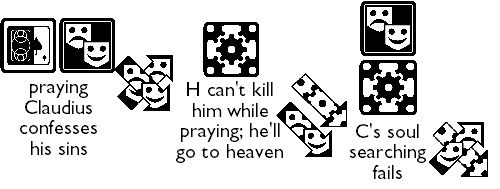The Claudius Conundrum

I've been shirking a homework assignment. After a close read of Hamlet's Hit Points, ![[info]](https://i.gr-assets.com/images/S/compressed.photo.goodreads.com/hostedimages/1380442897i/1319734.gif) nottheterritory wrote me to ask if I omitted a couple of seemingly important beats in Hamlet intentionally, or because I'm a big old bonehead.
nottheterritory wrote me to ask if I omitted a couple of seemingly important beats in Hamlet intentionally, or because I'm a big old bonehead.
Actually, he didn't say that last bit at all. He asked very kindly, as he is wont to do:
I notice that in the three .pdf versions, you do not cover either Claudius' "my offence is rank" or Hamlet's "now might I do it pat" soliloquies as beats. Indeed all the text versions of the play that I can find (and I admit I've only checked a few online) seem to differ with your structure of the play by placing those two soliloquies at the end of 3.iii and marking the scene in Gertrude's bed chamber as a new scene: 3.iv. I notice that you refer to the moment when discussing Hamlet and Gertrude in the bed chamber (3.3.C Hamlet Kills Polonius), writing:
"The upcoming scene where Hamlet approaches upon Claudius at prayer and vengefully decides not to kill him is of greater emotional, thematic and narrative importance than the earlier moment when Hamlet
makes fun of Polonius by getting him to agree that a cloud looks first like a camel, then like a weasel, then like a whale."
I'm assuming this suggests that you meant to mark those as beats since you're saying that (either singly or separately) they are more important than a moment you did mark as a beat (3.2.G – Hamlet Subjects Polonius to a Cloudy Jape). I also can't help but feel Claudius' admission of guilt qualifies as fairly big reveal!
As the mixed-up scene numbering suggest, this omission is just a plain old ordinary error on my part, committed during the original blogging process. I must have skipped around and never skipped back.
While the error doesn't undermine the RPG thesis of the book, it does mar the completeness of the Hamlet analysis.
Claudius' soliloquy does play like a reveal, although as the play is usually staged it's more of a confirmation of what we already assume than a surprise. It does however introduce a troubling note of dramatic ambiguity. As audience members, we've been happily perceiving Claudius as an antagonist, and rooting for Hamlet as he pursues his program of investigation and retribution. Suddenly we're thrust into Claudius' mind, through the device of the soliloquy, the Elizabethan theatrical delivery system for internal monologue. Now we suddenly find ourselves feeling sympathy for the wrongdoer, even as he's confessing his crime. He is the petitioner, seeking forgiveness. Depending on how you want to look at it, the silent granter is either an offstage and characteristically unresponsive God, or Claudius' own conscience.The ambiguity of our conflicted emotional response calls for crossed dramatic arrows.
More disorienting still is Hamlet's reaction as her overhears Claudius pray. He realizes that he can't kill him now, because he's confessing and will therefore go to heaven despite his crimes. Hamlet has to give up his clear shot at his enemy, postponing until he can catch him committing "some act / That has no relish of salvation in it", and kill him in the certain knowledge that he's headed to hell. This loss of the clear shot is a procedural downbeat, as it stops him from completing his practical goal. It also registers as an emotional downbeat, as we come to doubt our protagonist. As on board as we might be with Hamlet's mission of vengeance, we may recoil from his cold-bloodedness as he games the the holy system.
Then, when he leaves, Shakespeare both twists the procedural knife, and relieves the audience's emotional discomfort. Claudius loses his own petition to himself (or God), and is unable to find contrition. It's a procedural downbeat: ironically, Hamlet could have killed him and sent him to hell, but has now lost the chance. Dramatically, we recover our vengeful equilibrium, and get to go back to sympathizing with Hamlet and anathematizing Claudius. The villain's distress is our satisfaction, as one half of another ambiguous beat.



